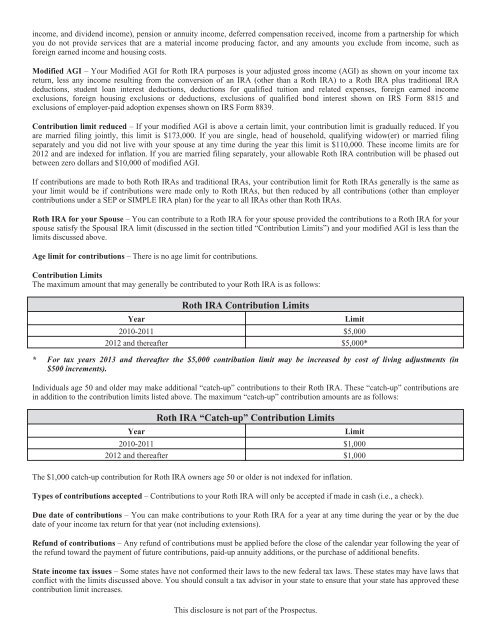Prudential Premier Retirement Variable Annuities
Prudential Premier Retirement Variable Annuities
Prudential Premier Retirement Variable Annuities
You also want an ePaper? Increase the reach of your titles
YUMPU automatically turns print PDFs into web optimized ePapers that Google loves.
income, and dividend income), pension or annuity income, deferred compensation received, income from a partnership for which<br />
you do not provide services that are a material income producing factor, and any amounts you exclude from income, such as<br />
foreign earned income and housing costs.<br />
Modified AGI – Your Modified AGI for Roth IRA purposes is your adjusted gross income (AGI) as shown on your income tax<br />
return, less any income resulting from the conversion of an IRA (other than a Roth IRA) to a Roth IRA plus traditional IRA<br />
deductions, student loan interest deductions, deductions for qualified tuition and related expenses, foreign earned income<br />
exclusions, foreign housing exclusions or deductions, exclusions of qualified bond interest shown on IRS Form 8815 and<br />
exclusions of employer-paid adoption expenses shown on IRS Form 8839.<br />
Contribution limit reduced – If your modified AGI is above a certain limit, your contribution limit is gradually reduced. If you<br />
are married filing jointly, this limit is $173,000. If you are single, head of household, qualifying widow(er) or married filing<br />
separately and you did not live with your spouse at any time during the year this limit is $110,000. These income limits are for<br />
2012 and are indexed for inflation. If you are married filing separately, your allowable Roth IRA contribution will be phased out<br />
between zero dollars and $10,000 of modified AGI.<br />
If contributions are made to both Roth IRAs and traditional IRAs, your contribution limit for Roth IRAs generally is the same as<br />
your limit would be if contributions were made only to Roth IRAs, but then reduced by all contributions (other than employer<br />
contributions under a SEP or SIMPLE IRA plan) for the year to all IRAs other than Roth IRAs.<br />
Roth IRA for your Spouse – You can contribute to a Roth IRA for your spouse provided the contributions to a Roth IRA for your<br />
spouse satisfy the Spousal IRA limit (discussed in the section titled “Contribution Limits”) and your modified AGI is less than the<br />
limits discussed above.<br />
Age limit for contributions – There is no age limit for contributions.<br />
Contribution Limits<br />
The maximum amount that may generally be contributed to your Roth IRA is as follows:<br />
Roth IRA Contribution Limits<br />
Year Limit<br />
2010-2011 $5,000<br />
2012 and thereafter $5,000*<br />
* For tax years 2013 and thereafter the $5,000 contribution limit may be increased by cost of living adjustments (in<br />
$500 increments).<br />
Individuals age 50 and older may make additional “catch-up” contributions to their Roth IRA. These “catch-up” contributions are<br />
in addition to the contribution limits listed above. The maximum “catch-up” contribution amounts are as follows:<br />
Roth IRA “Catch-up” Contribution Limits<br />
Year Limit<br />
2010-2011 $1,000<br />
2012 and thereafter $1,000<br />
The $1,000 catch-up contribution for Roth IRA owners age 50 or older is not indexed for inflation.<br />
Types of contributions accepted – Contributions to your Roth IRA will only be accepted if made in cash (i.e., a check).<br />
Due date of contributions – You can make contributions to your Roth IRA for a year at any time during the year or by the due<br />
date of your income tax return for that year (not including extensions).<br />
Refund of contributions – Any refund of contributions must be applied before the close of the calendar year following the year of<br />
the refund toward the payment of future contributions, paid-up annuity additions, or the purchase of additional benefits.<br />
State income tax issues – Some states have not conformed their laws to the new federal tax laws. These states may have laws that<br />
conflict with the limits discussed above. You should consult a tax advisor in your state to ensure that your state has approved these<br />
contribution limit increases.<br />
This disclosure is not part of the Prospectus.

















